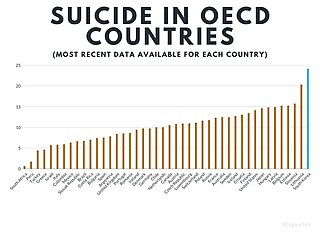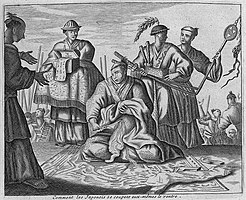Face is a class of behaviors and customs, associated with the morality, honor, and authority of an individual, and its image in social groups.
Japanese values are cultural goals, beliefs and behaviors that are considered important in Japanese culture. From a global perspective, Japanese culture stands out for its higher scores in emancipative values, individualism, and flexibility compared to many other cultures around the world. There is a similar level of emphasis on these values in the cultures of the United States and Japan. However cultures from Western Europe surpass it in these aspects. Overall, Japanese society exhibits unique characteristics influenced by personal connections, consensus building, and a strong sense of community consciousness. These features have deep historical roots and reflect the values ingrained in Japanese society.

Harakiri is a 1962 Japanese jidaigeki film directed by Masaki Kobayashi. The story takes place between 1619 and 1630 during the Edo period and the rule of the Tokugawa shogunate. It tells the story of the rōnin Hanshirō Tsugumo, who requests to commit seppuku (harakiri) within the manor of a local feudal lord, using the opportunity to explain the events that drove him to ask for death before an audience of samurai. The film continues to receive critical acclaim, often considered one of the best samurai pictures ever made as well as one of the greatest films ever made.
A label is an abstract concept in sociology used to group people together based on perceived or held identity. Labels are a mode of identifying social groups. Labels can create a sense of community within groups, but they can also cause harm when used to separate individuals and groups from mainstream society. Individuals may choose a label, or they may be assigned one by others. The act of labeling may affect an individual's behavior and their reactions to the social world.

In the fields of sociology and criminology, strain theory is a theoretical perspective that aims to explain the relationship between social structure, social values or goals, and crime. Strain theory was originally introduced by Robert King Merton (1938), and argues that society's dominant cultural values and social structure causes strain, which may encourage citizens to commit crimes. Following on the work of Émile Durkheim's theory of anomie, strain theory has been advanced by Robert King Merton (1938), Albert K. Cohen (1955), Richard Cloward, Lloyd Ohlin (1960), Neil Smelser (1963), Robert Agnew (1992), Steven Messner, Richard Rosenfeld (1994) and Jie Zhang (2012).
In social psychology, social salience is the extent to which a particular target draws the attention of an observer or group. The target may be a physical object or a person. If the target is a person, they may be alone or a member of a group or else in a situation of interpersonal communication. It is based on the way a particular feature can be linked to a certain type of speaker, who is then associated with social and emotional evaluations. These evaluations are then transferred to the linguistic feature.
According to some theories, emotions are universal phenomena, albeit affected by culture. Emotions are "internal phenomena that can, but do not always, make themselves observable through expression and behavior". While some emotions are universal and are experienced in similar ways as a reaction to similar events across all cultures, other emotions show considerable cultural differences in their antecedent events, the way they are experienced, the reactions they provoke and the way they are perceived by the surrounding society. According to other theories, termed social constructionist, emotions are more deeply culturally influenced. The components of emotions are universal, but the patterns are social constructions. Some also theorize that culture is affected by the emotions of the people.
In Japan, suicide is considered a major social issue. In 2017, the country had the seventh highest suicide rate in the OECD, at 14.9 per 100,000 persons, and in 2019 the country had the second highest suicide rate among the G7 developed nations.
Optimal distinctiveness is a social psychological theory seeking to understand ingroup–outgroup differences. It asserts that individuals desire to attain an optimal balance of inclusion and distinctiveness within and between social groups and situations. These two motives are in constant opposition with each other; when there is too much of one motive, the other must increase in order to counterbalance it and vice versa. The theory of optimal distinctiveness was first proposed by Dr. Marilynn B. Brewer in 1991 and extensively reviewed in 2010 by Drs. Geoffrey J. Leonardelli, Cynthia L. Pickett, and Marilynn Brewer.

Suicide in South Korea occurs at the 12th highest rate in the world. South Korea has the highest recorded suicide rate in the OECD. In South Korea, it is estimated to affect 0.02 percent of the population by the WHO. In 2012, suicide was the fourth-highest cause of death. The suicide rate has consistently declined between 2012 and 2019, the year when the latest data are available.

Seppuku, also called harakiri, is a form of Japanese ritualistic suicide by disembowelment. It was originally reserved for samurai in their code of honour, but was also practised by other Japanese people during the Shōwa era to restore honour for themselves or for their families.
Social determinism is the theory that social interactions alone determine individual behavior.
Culture defines how people view the world and certain phenomena. Culture also appears to influence the way people experience depression. An individual's experience with depression can vary from country to country. For example, a qualitative study revealed that some countries did not recognize post-natal depression as an illness; rather, it was viewed as a state of unhappiness that did not require any health interventions.

The theory of basic human values is a theory of cross-cultural psychology and universal values that was developed by Shalom H. Schwartz. The theory extends previous cross-cultural communication frameworks such as Hofstede's cultural dimensions theory. Schwartz identifies ten basic human values, each distinguished by their underlying motivation or goal, and he explains how people in all cultures recognize them. There are two major methods for measuring these ten basic values: the Schwartz Value Survey and the Portrait Values Questionnaire.
A forgiveness scale is a psychological test that attempts to measure a person's willingness to forgive. A true definition of forgiveness is debated by many researchers, yet Hargrave suggests that forgiveness refers to releasing resentment towards an offender.
In cultural anthropology, the distinction between a guilt society or guilt culture, shame society or shame culture, and a fear society or culture of fear, has been used to categorize different cultures. The differences can apply to how behavior is governed with respect to government laws, business rules, or social etiquette. This classification has been applied especially to what anthropologist Ruth Benedict called "apollonian" societies, sorting them according to the emotions they use to control individuals and maintaining social order, swaying them into norm obedience and conformity.
"Suicidal ideation" or suicidal thoughts are the precursors of suicide, which is the leading cause of death among youth. Ideation or suicidal thoughts are categorized as: considering, seriously considering, planning, or attempting suicide and youth is typically categorized as individuals below the age of 25. Various research studies show an increased likelihood of suicide ideation in youth in the LGBT community.
In social psychology, social projection is the psychological process through which an individual expects behaviors or attitudes of others to be similar to their own. Social projection occurs between individuals as well as across ingroup and outgroup contexts in a variety of domains. Research has shown that aspects of social categorization affect the extent to which social projection occurs. Cognitive and motivational approaches have been used to understand the psychological underpinnings of social projection as a phenomenon. Cognitive approaches emphasize social projection as a heuristic, while motivational approaches contextualize social projection as a means to feel connected to others. In contemporary research on social projection, researchers work to further distinguish between the effects of social projection and self-stereotyping on the individual’s perception of others.
The psychology of social class is a branch of social psychology dedicated to understanding how social class affects individual's thoughts, feelings, and behaviors. While social class has long been a subject of analysis in fields such as sociology, political science, anthropology, medicine and epidemiology, its emergence within the field of psychology is much more recent.

In social psychology, the two axes of subordination is a racial position model that categorizes the four most common racial groups in the United States into four different quadrants. The model was first proposed by Linda X. Zou and Sapna Cheryan in the year 2017, and suggests that U.S. racial groups are categorized based on two dimensions: perceived inferiority and perceived cultural foreignness. Support for the model comes from both a target and perceivers perspective in which Whites are seen as superior and American, African Americans as inferior and American, Asian Americans as superior and foreign, and Latinos as inferior and foreign.









